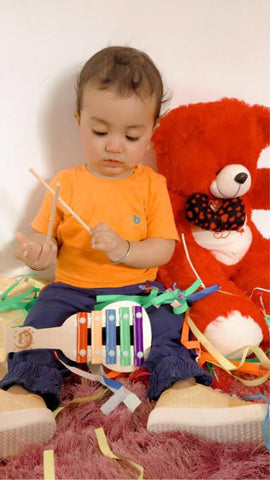Xylophone for Kids: An Introduction to Musical Exploration

Xylophones are not just musical instruments; they are gateways to a world of creativity and exploration for children. With their vibrant colors and melodic sounds, xylophones have long been a favorite among young aspiring musicians. In this article, we will delve into the world of xylophones for kids, exploring their benefits, how to choose the right one, safety considerations, tips for teaching, fun activities, and their role in early childhood education.
Benefits of Playing the Xylophone
Cognitive Development
Playing the xylophone involves hand-eye coordination, memory recall, and pattern recognition. As children learn to hit the right keys to produce the desired notes, they are also developing their cognitive abilities.
Motor Skills Enhancement
The act of striking the keys of a xylophone with mallets helps children refine their fine motor skills and hand dexterity. This is particularly beneficial for younger children who are still developing these abilities.
Musical Education
Introducing children to the world of music at an early age can foster a lifelong appreciation for the arts. Learning to play the xylophone introduces them to basic musical concepts such as rhythm, melody, and harmony.
Choosing the Right Xylophone for Your Child
When selecting a xylophone for your child, there are several factors to consider to ensure you choose the best option for their needs.
Material and Durability
Opt for xylophones made from sturdy materials such as wood or metal. These materials are durable and can withstand the inevitable wear and tear that comes with regular use.
Size and Portability
Consider the size and portability of the xylophone, especially if your child will be taking it to music lessons or on the go. Look for compact designs that are easy to transport.
Sound Quality
Pay attention to the sound quality of the xylophone. Choose instruments with clear, resonant tones that will inspire your child to play and explore music.
Safety Considerations
While xylophones can provide hours of musical fun, it's essential to prioritize safety when choosing and using these instruments with children.
Age Appropriateness
Ensure that the xylophone is age-appropriate for your child. Avoid instruments with small parts that could pose a choking hazard for younger children.
Non-toxic Materials
Opt for xylophones made from non-toxic materials to ensure the safety of your child, especially if they are prone to putting objects in their mouths.
Sharp Edges and Small Parts
Inspect the xylophone for any sharp edges or small parts that could cause injury. Choose instruments with rounded edges and securely attached parts.

Tips for Teaching Kids to Play the Xylophone
Teaching children to play the xylophone can be a rewarding experience for both parents and educators. Here are some tips to help you get started.
Start with Simple Songs
Begin with simple songs and melodies to build your child's confidence and familiarity with the instrument.
Encourage Exploration
Encourage your child to explore the xylophone and experiment with different sounds and rhythms. This will help foster their creativity and musical expression.
Practice Regularly
Consistent practice is key to mastering any instrument. Set aside dedicated time each day for your child to practice playing the xylophone.
Fun Xylophone Activities for Kids
Make learning to play the xylophone even more enjoyable with these fun activities and games.
Color-Coded Music Sheets
Create color-coded music sheets to help children learn to read music while playing the xylophone. Assign a color to each note to make learning more accessible and engaging.
Xylophone Band
Encourage children to form a xylophone band with their friends or siblings. They can take turns playing different parts of a song or create their compositions.
Musical Games
Incorporate musical games into xylophone practice sessions to keep children motivated and entertained. Games like musical chairs or Simon Says can help reinforce musical concepts while having fun.
Incorporating Xylophones into Early Childhood Education
Xylophones can be valuable tools for educators looking to enhance their early childhood curriculum.
Classroom Activities
Integrate xylophones into classroom activities to teach children about rhythm, melody, and teamwork. Group music sessions can promote social interaction and cooperation among students.
Group Learning
Encourage group learning and collaboration by having children play together in small ensembles. This fosters a sense of community and encourages children to support and learn from one another.
Creative Expression
Use xylophones as a means of creative expression in the classroom. Encourage children to compose their melodies and perform them for their peers, fostering confidence and self-expression.
Conclusion
Xylophones are more than just toys; they are powerful tools for fostering creativity, cognitive development, and musical education in children. By choosing the right instrument, prioritizing safety, and incorporating fun activities and games, parents and educators can help children unlock their musical potential from an early age.
FAQs
Q 1: What age is suitable for children to start learning the xylophone?
A 1: Children as young as three or four years old can start learning the basics of playing the xylophone with supervision and guidance.
Q 2: How can I ensure the xylophone is safe for my child to use?
A 2: Choose xylophones made from child-safe materials, inspect for any sharp edges or small parts, and always supervise children during play.
Q 3: Do xylophones require any maintenance?
A 3: Regular cleaning and occasional tuning may be necessary to keep the xylophone in optimal condition. Follow manufacturer guidelines for maintenance.
Q 4: Can playing the xylophone help my child academically?
A 4: Yes, studies have shown that learning to play a musical instrument like the xylophone can improve academic performance, particularly in subjects like math and language arts.
Q 5: How can I encourage my child to practice playing the xylophone regularly?
A 5: Make practice sessions fun and engaging by incorporating games, rewards, and praise for their progress.
-
Posted in
Xylophones for Kids





















































